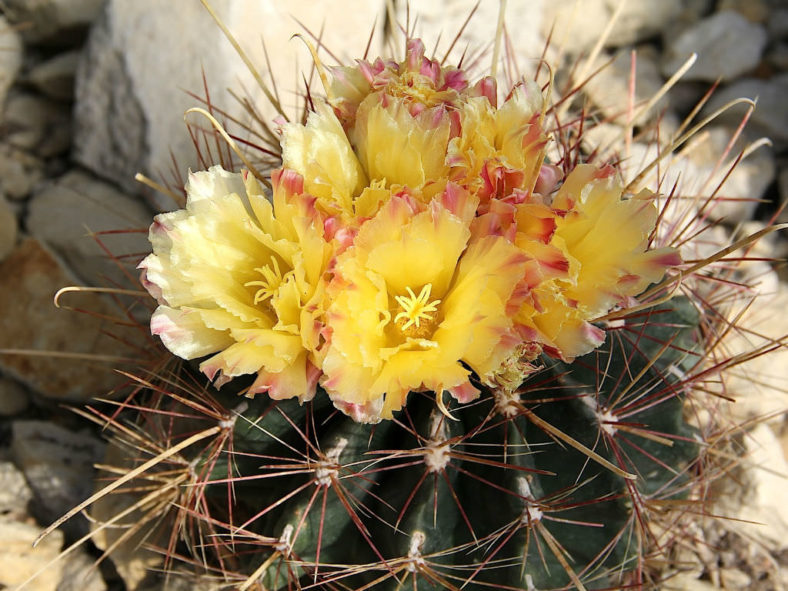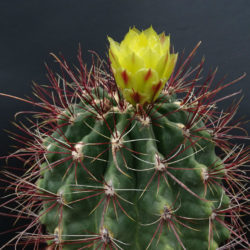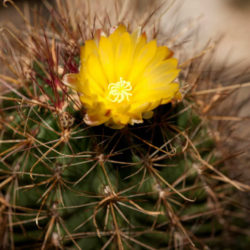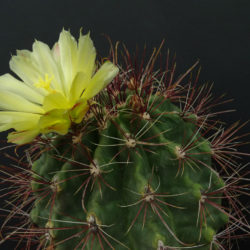Scientific Name
Ferocactus hamatacanthus (Muehlenpf.) Britton & Rose
Common Name(s)
Mexican Fruit Cactus, Texas Barrel Cactus, Turk's-head Barrel Cactus
Synonym(s)
Echinocactus hamatacanthus, Ferocactus hamatacanthus subsp. hamatacanthus, Hamatocactus hamatacanthus
Scientific Classification
Family: Cactaceae
Subfamily: Cactoideae
Tribe: Cacteae
Genus: Ferocactus
Description
Ferocactus hamatacanthus is a cactus with an erect, spherical to short cylindrical, usually solitary stem with 12 to 17 prominent, narrow to rounded, tuberculate ribs. The stems can grow up to 24 inches (60 cm) tall and 12 inches (30 cm) in diameter. The spines are pinkish-brown or straw-colored. Each areole bears 4 to 8 central and 8 to 20 radial spines. The central spines are round to strongly flattened, curved backward to hooked at the tip, very flexible, and can reach 6.6 inches (16.5 cm) in length. The radial spines are more or less straight and can reach 3.2 inches (8 cm) in length.
The flowers are funnel-shaped with well-developed floral tubes, reaching 4 inches (10 cm) in length and 3.8 inches (9.5 cm) in diameter. They are yellow and appear at the top of the stem in summer. The fruits are edible, green to maroon, ovoid to oblong, measuring up to 2 inches (5 cm) long and 1.2 inches (3 cm) in diameter, and filled with juicy pulp and seeds.
Origin
Ferocactus hamatacanthus is widespread in the Chihuahuan Desert in northwestern Mexico and New Mexico and southwestern Texas in the United States.

Hardiness
USDA hardiness zone 6a to 11b: from −10 °F (−23.3 °C) to 50 °F (+10 °C).
How to Grow and Care
Choose a planting location that receives direct sun during all or most of the day. Because Ferocactus eventually leans into the sun instead of growing precisely upright and because it has extremely sharp thorns, place it where people will not brush into it accidentally.
Plant your cactus in early spring before new roots begin to form in late June and early July. The roots may appear dry, which is typical before new growth begins. Dig a hole deep enough for the plant's roots and amend it as needed to provide fast-draining soil. A good soil mixture includes 10 percent native soil, 45 percent washed sand or pumice, and 45 percent compost. Ferocactus thrive in poor and arid soil.
Water the cactus at the time of planting to anchor it into the soil. Water again only if the weather in your area is unseasonably dry and if normal spring or winter rainfall doesn't occur.
See more at How to Grow and Care for Ferocactus.
Subspecies
Links
- Back to genus Ferocactus
- Succupedia: Browse succulents by Scientific Name, Common Name, Genus, Family, USDA Hardiness Zone, Origin, or cacti by Genus
Photo Gallery
Click on a photo to see a larger version.


